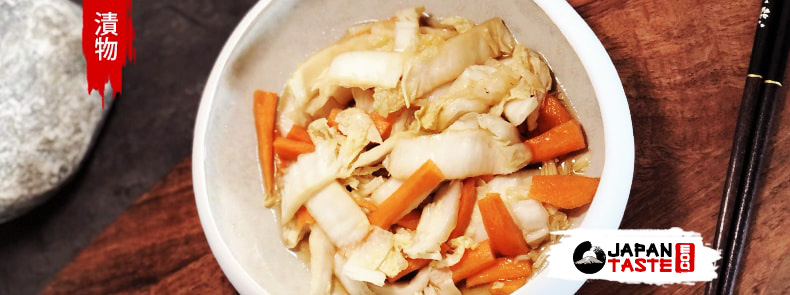Tsukemono 漬物 is the generic term used for macerated foods. These are for example vegetables, fruits or even seaweeds preserved in various ingredients and marinades such as rice vinegar salt, the miso or even shoyu soy sauce. Once covered, these tsukemono in the making are stored in a container for a very long time. They become softer and softer as they shrink. They become impregnated with the surrounding brine and take on a beautiful colored hue. Their taste is then amplified and exalted. This is a perfect accompaniment to japanese white rice.
- Tsukemono, foods that are omnipresent in Japanese dishes
- Families of tsukemono
- Examples of tsukemono marinades
- Examples of foods used in tsukemono
- Some of the most famous tsukemono
Tsukemono, ubiquitous food in Japanese dishes
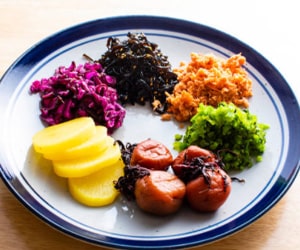 Japanese people love tsukemono. Tsukemono are indeed omnipresent in Japanese cuisine: they are found at every meal, from breakfast to dinner and even as an appetizer. No matter what the meal, whether it is a simple bento or a Japanese haute cuisine like kaiseki, you will notice the presence of these famous tsukemono. The most famous of them all are certainly the plum umeboshi which is a classic and the pickled ginger which accompanies the sushi. Their texture is either crunchy or melting but in any case refreshing and tasty. Tsukemono are light, low in calories and full of vitamins. You will find them more or less salty, sour, sweet, spicy or even hot for some, directly in the dish or placed in a small container next to it.
Japanese people love tsukemono. Tsukemono are indeed omnipresent in Japanese cuisine: they are found at every meal, from breakfast to dinner and even as an appetizer. No matter what the meal, whether it is a simple bento or a Japanese haute cuisine like kaiseki, you will notice the presence of these famous tsukemono. The most famous of them all are certainly the plum umeboshi which is a classic and the pickled ginger which accompanies the sushi. Their texture is either crunchy or melting but in any case refreshing and tasty. Tsukemono are light, low in calories and full of vitamins. You will find them more or less salty, sour, sweet, spicy or even hot for some, directly in the dish or placed in a small container next to it.
The tsukemono is easily made, the Japanese make it at home although they are very present in Japanese supermarkets and markets.
The families of tsukemono
Asazuke (浅 漬 け)
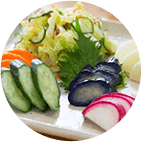 Asazuke literally means “lightly pickled.” Although the name is usually used for salt-based tsukemono, this name could be given for any tsukemono that has not begun to ferment
Asazuke literally means “lightly pickled.” Although the name is usually used for salt-based tsukemono, this name could be given for any tsukemono that has not begun to ferment
Shiozuke (塩 漬 け)
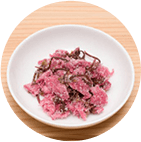 Shiozuke simply means “saltedtsukemono “. It is used to refer to any tsukemono prepared with salt or a salt-based brine. In the picture, for example, it is a tsukemono of cherry blossom marinated in salt for infusions for example. Use sparingly because it is very salty!
Shiozuke simply means “saltedtsukemono “. It is used to refer to any tsukemono prepared with salt or a salt-based brine. In the picture, for example, it is a tsukemono of cherry blossom marinated in salt for infusions for example. Use sparingly because it is very salty!
Shoyuzuke (醤 油漬 け)
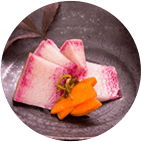 Shoyuzuke means “tsukemono with soy sauce.” This usually includes root vegetables such as carrots, burdock and garlic, but it can also include other foods such as salmon roe or mushrooms.
Shoyuzuke means “tsukemono with soy sauce.” This usually includes root vegetables such as carrots, burdock and garlic, but it can also include other foods such as salmon roe or mushrooms.
Amasuzuke (甘酢漬け)
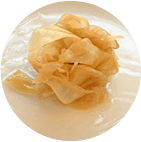 Amasuzuke is used to pickle fresh vegetables in sweet vinegar. Among these, we can re-cite the example we saw above namely, the “Gari” or ginger pickled in sushi.
Amasuzuke is used to pickle fresh vegetables in sweet vinegar. Among these, we can re-cite the example we saw above namely, the “Gari” or ginger pickled in sushi.
Misozuke (味噌漬け)
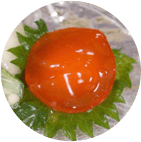 Misozuke are ingredients pickled in miso, fermented soybean paste or a combination of it with for example sake, mirin or sugar. Here we have a tamago misozuke, with pickled egg yolk.
Misozuke are ingredients pickled in miso, fermented soybean paste or a combination of it with for example sake, mirin or sugar. Here we have a tamago misozuke, with pickled egg yolk.
Kasuzuke (粕漬け) or Narazuke (奈良漬)
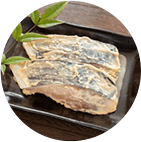 Kasuzuke or narazuke is made from sake lees, which is the leftovers from the refining process of sake production.
Kasuzuke or narazuke is made from sake lees, which is the leftovers from the refining process of sake production.
Karashizuke (からし漬け)
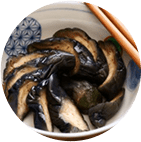 Karashizuke is made from japanese mustard karashi. Eggplant-based nasu karashizuke is one of the most popular karashizuke.
Karashizuke is made from japanese mustard karashi. Eggplant-based nasu karashizuke is one of the most popular karashizuke.
Nukazuke (糠 漬 け)
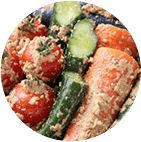 Another popular tsukemono is “nukazuke” (糠 漬 け). The foods are fermented in rice bran (“numa” 糠). They are often eaten at the end of a meal and are said to aid in digestion.
Another popular tsukemono is “nukazuke” (糠 漬 け). The foods are fermented in rice bran (“numa” 糠). They are often eaten at the end of a meal and are said to aid in digestion.
Satozuke (砂糖漬け)
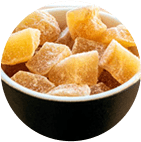 Satozuke is made with sugar. We could compare it with the candied fruits found at home, but it is not only fruits in Japan since there are also other foods like ginger or lotus flower root.
Satozuke is made with sugar. We could compare it with the candied fruits found at home, but it is not only fruits in Japan since there are also other foods like ginger or lotus flower root.
Suzuke (酢漬け)
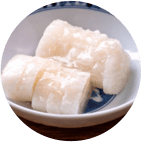 Suzuke is made mainly with vinegar. Vinegar has the advantage of having an antibacterial effect, improves metabolism and regulates the intestinal environment
Suzuke is made mainly with vinegar. Vinegar has the advantage of having an antibacterial effect, improves metabolism and regulates the intestinal environment
Examples of tsukemono marinade:

Salt

Rice Vinegar

Soy sauce japanese shoyu soy sauce

Sake

Koji

Karashi

Mirin or sugar

Miso
Due to the many preservation methods, there are hundreds of varieties of tsukemono in Japan with specific styles and ingredients depending on the region and season. There are now more than 4,000 different kinds! Strolling in Japanese markets, you can taste several kinds of tsukemono in some stalls.
Examples of foods used in tsukemono:

Daikon

Ginger

Plum (ume)

Turnip (kabu)

Cucumber (kyuri)

Chinese Cabbage

Lotus Root (renkon)

Eggplant (nasu)

Onions (tamanegi)

Japanese Seaweed

Shiso

Wasabi Leaves
The foods used for tsukemono are many and include roots, eggs, meat, fish, all kinds of seafood, and even flowers. Far from being monotonous, tsukemono offer endless possibilities, with diverse shapes, colors and flavors. They include all the flavors umami. No wonder they are a wonderful accompaniment to dishes
Some of the most famous tsukemono:
Umeboshi 梅干
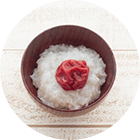 L’umeboshi is one of the very popular tsukemono in Japan. It is a salty plum that has been reddened by the shiso leaves. In Japan, it is found in the middle of white rice, in bento and also in onigiri.
L’umeboshi is one of the very popular tsukemono in Japan. It is a salty plum that has been reddened by the shiso leaves. In Japan, it is found in the middle of white rice, in bento and also in onigiri.
Beni Shoga 紅生姜
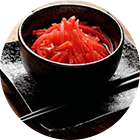 Beni Shoga is recognizable by its bright red color, it is pickled ginger. It is used in popular Japanese dishes such as okonomiyaki and yakisoba or even the gyudon.
Beni Shoga is recognizable by its bright red color, it is pickled ginger. It is used in popular Japanese dishes such as okonomiyaki and yakisoba or even the gyudon.
Takuan or takuwan 沢庵
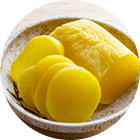 Takuan is pickled daikon, it is recognizable by its bright yellow color. It is often eaten at the end of a meal to aid digestion.
Takuan is pickled daikon, it is recognizable by its bright yellow color. It is often eaten at the end of a meal to aid digestion.
Kyuri no nukazuke
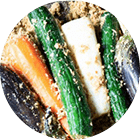 Cucumber is one of the favorite vegetables in tsukemono. It is crunchy and very refreshing.
Cucumber is one of the favorite vegetables in tsukemono. It is crunchy and very refreshing.
Nasuzuke な す 漬
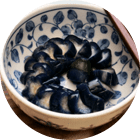 These are the small Japanese eggplants that are fully marinated and sliced.
These are the small Japanese eggplants that are fully marinated and sliced.
Sakura 桜
 When the cherry blossom festival comes called Hanami, it appears in Japanese cuisine pastries and dishes made of flowers and sakura leaf. These flowers and leaves are macerated in salt like shiozuke, but are used to make for example sakura mochi sakura tea or soba. The tsukemono in supermarkets often have chemical additives that are bad for your health, that’s why we advise you to make your tsukemono at home, because they are easily made. Here is our tukemono recipe Chinese cabbage carrots and our recipe for tsukemono of marinated garlic with soy sauce. Tsukemono are a great way to enhance and spice up dishes and are really practical for making express recipe with japanese white rice
When the cherry blossom festival comes called Hanami, it appears in Japanese cuisine pastries and dishes made of flowers and sakura leaf. These flowers and leaves are macerated in salt like shiozuke, but are used to make for example sakura mochi sakura tea or soba. The tsukemono in supermarkets often have chemical additives that are bad for your health, that’s why we advise you to make your tsukemono at home, because they are easily made. Here is our tukemono recipe Chinese cabbage carrots and our recipe for tsukemono of marinated garlic with soy sauce. Tsukemono are a great way to enhance and spice up dishes and are really practical for making express recipe with japanese white rice


